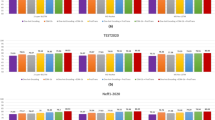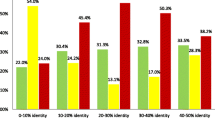Abstract
The pair-coupled amino acid composition is introduced to predict the secondary structure contents of a protein. Compared with the existing methods all based on singlewise amino acid composition as defined in a 20D (dimensional) space, this represents a step forward to the consideration of the sequence coupling effect. The test results indicate that the introduction of the pair-coupled amino acid composition can significantly improve the prediction quality. It is anticipated that the concept of the pair-coupled amino acid composition can be used to simplify the formulation of sequence coupling (or sequence order) effects and to study many other features of proteins as well.
Similar content being viewed by others
REFERENCES
Anfinsen, C. G. (1973). Principles that govern folding of protein chains. Science, 181, 223-223.
Bahar, I., Atilgan, A. R., Jernigan, R. L., and Erman, B. (1997). Understanding the recognition of protein structural classes by amino acid composition. Proteins, 29, 172-185.
Bussian, B. M., and Sander, C. (1989). How to determine protein secondary structure in solution by Raman spectroscopy: Practical guide and test case DNase I. Biochemistry, 28, 4271-4277.
Chandonia, J. M., and Karplus, M. (1995). Neural networks for secondary structure and structural class prediction. Protein Science, 4, 275-285.
Chou, K. C. (1993). A vectorized sequence-coupling model for predicting HIV protease cleavage sites in proteins. Journal of Biological Chemistry, 268, 16938-16948.
Chou, K. C. (1995a). A novel approach to predicting protein structural classes in a (20–1)-D amino acid composition space. Proteins: Structure, Function and Genetics, 21, 319-344.
Chou, K. C. (1995b). A sequence-coupled vector-projection model for predicting the specificity of GalNAc-transferase. Protein Science, 4, 1365-1383.
Chou, K. C. (1996). Review: Prediction of human immunodeficiency virus protease cleavage sites in proteins. Analytical Biochemistry, 233, 1-14.
Chou, K. C. (1997a). Prediction of β-turns. Journal of Peptide Research, 49, 120-144.
Chou, K. C. (1997b). Prediction and classification of α-turn types. Biopolymers, 42, 837-853.
Chou, K. C., and Blinn, J. R. (1997). Classification and prediction of β-turn types. Journal of Protein Chemistry, 16, 575-595.
Chou, K. C., and Maggiora, G. M. (1998). Domain structural class prediction. Protein Engineering, 11, 523-538.
Chou, K. C., and Zhang, C. T. (1995). Review: Prediction of protein structural classes. Critical Reviews in Biochemistry and Molecular Biology, 30, 275-349.
Chou, K. C., Liu, W., Maggiora, G. M., and Zhang, C. T. (1998). Prediction and classification of domain structural classes. Proteins: Structure, Function and Genetics, 31, 97-103.
Chou, P. Y. (1980). Amino acid composition of four classes of proteins, in Abstracts of Papers, Part I, Second Chemical Congress of the North American Continent, Las Vegas.
Chou, P. Y. (1989). Prediction of protein structural classes from amino acid composition, in Prediction of Protein Structure and the Principles of Protein Conformation (Fasman, G. D., ed.), Plenum Press, New York, pp. 549-586.
Chou, P. Y., and Fasman, G. D. (1978). Prediction of secondary structure of proteins from amino acid sequence. Advances in Enzymology and Related Subjects in Biochemistry, 47, 45-148.
Dubchak, I., Holbrook, S. R., and Kim, S.-H. (1993). Predicting protein secondary structure content: A tandem neural network approach. Proteins 16, 79-91.
Fasman, G. D. (1989). The development of the prediction of protein structure, in Prediction of Protein Structure and the Principles of Protein Conformation (Fasman, G. D., ed.), Plenum Press, New York, pp. 317-358.
Kabsch, W., and Sander, C. (1983). Dictionary of protein secondary structure: Pattern recognition of hydrogen-bonded and geometrical features. Biopolymers, 22, 2577-2637.
Klein, P., and Delisi, C. (1986). Prediction of protein structural class from amino acid sequence. Biopolymers, 25, 1659-1672.
Krigbaum, W. R., and Knutton, S. P. (1973). Prediction of the amount of secondary structure in a globular protein from its aminoacid composition. Proceedings of the National Academy of Science of the USA, 70, 2809-2813.
Metfessel, B. A., Saurugger, P. N., Connelly, D. P., and Rich, S. T. (1993). Cross-validation of protein structural class prediction using statistical clustering and neural networks. Protein Science, 2, 1171-1182.
Muskal, S. M., and Kim, S.-H. (1992). Predicting protein secondary structure content: A tandem neural network approach. Journal of Molecular Biology, 225, 713-727.
Nakashima, H., Nishikawa, K., and Ooi, T. (1986). The folding type of a protein is relevant to the amino acid composition. Journal of Biochemistry, 99, 152-162.
Sreerama, N., and Woody, R. W. (1994). Protein secondary structure from circular dichroism spectroscopy. Journal of Molecular Biology, 242, 497-507.
Zhang, C. T., and Chou, K. C. (1994). An alternate-subsite-coupled model for predicting HIV protease sites in proteins. Protein Engineering, 7, 65-73.
Zhang, C. T., Zhang, Z., and He, Z. (1996a). Prediction of the secondary structure content of globular proteins based on structural classes. Journal of Protein Chemistry, 15, 775-786.
Zhang, C. T., Zhang, Z., and He, Z. (1996b). Prediction of the secondary structure content of globular proteins based on three structural classes. Journal of Protein Chemistry, 17, 261-272.
Zhou, G. P. (1998). An intriguing controversy over protein structural class prediction. Journal of Protein Chemistry, 17, 729-738.
Author information
Authors and Affiliations
Rights and permissions
About this article
Cite this article
Chou, KC. Using Pair-Coupled Amino Acid Composition to Predict Protein Secondary Structure Content. J Protein Chem 18, 473–480 (1999). https://doi.org/10.1023/A:1020696810938
Published:
Issue Date:
DOI: https://doi.org/10.1023/A:1020696810938




